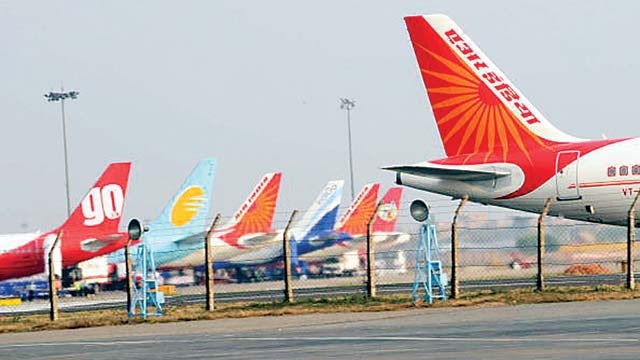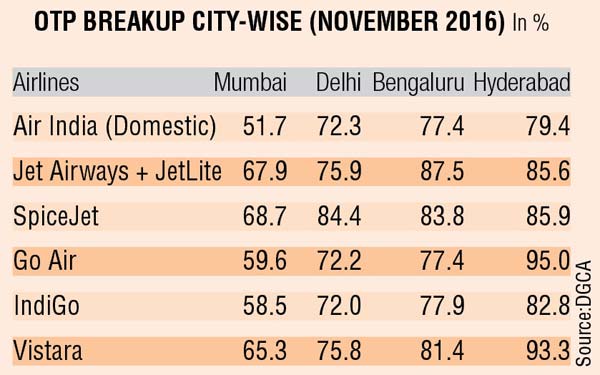
While allegations of airlines fudging one-time performance (OTP) fly, the aviation industry insiders and experts claim that the average OTP of the airlines may deteriorate in coming years due to several factors, primarily the addition of more capacity which may further congest the airspace of major airports.
The on-time performance is a key performance metric for airlines that shows how frequently its flights operate within its scheduled declared time. Therefore, it becomes an important marketing tool for attracting the passengers as well as financiers and other stakeholders, by assuring the former that the flights will reach the destination on time and the latter that the airline is using its assets optimally.
While the airlines topping the OTP ranking are known to blow their trumpet, the rivals, on the other hand, question the parameters of collating the OTP, which they claim is flawed and full of loopholes, and therefore, prone to be fudged and manipulated.
No-frills carrier IndiGo, which till recently had been boasting about its OTP as its USP, alleged manipulation in the measurement of OTP at Mumbai's Chhatrapati Shivaji International Airport (CSIA) when SpiceJet claimed highest rankings in past five months.
Last week, in a complaint to Directorate General of Civil Aviation (DGCA), IndiGo alleged that the OTP monitoring by airport operator MIAL (Mumbai International Airport Limited) is done in such a way that it shows some of its "competing airline" as more punctual than the others, which may actually not be the case.

However, Kamal Hingorani, senior VP (flight services and customer experience) at SpiceJet says, "No airline has done that in past and it's a historic record at CSIA." He gives an example of US-based Southwest Airlines which has managed to remain profitable for several decades by concentrating on its OTP. On the other hand, many of its rivals floundered to bankruptcy.
"Southwest constantly hit the turn-around time of 20 minutes, which later became a new normal for most airports in the developed world. We want to do that in India," Hingorani adds.
It is pertinent to note that a near-bankrupt SpiceJet which almost ceased operations in December 2014 made a dramatic turnaround and currently has a market share of 12.7%.
But SpiceJet's performance has not been so impressive at Delhi's Indira Gandhi International Airport (IGIA), except for the months of October and November. Hingorani says, "We are definitely improving there too in the next few months".
Giving a further context to the issue of OTP performance, Ajay Jasra, head of corporate communications at IndiGo explains, "IndiGo flies four times more flights than the airline you have compared us with and during peak hours (morning /evening) we fly 5 to 8 more flights than them (SpiceJet) in Mumbai. So there is no comparison between the two."
However, according to a research report by ICICI securities released late last month, IndiGo's OTP has been deteriorating. "There has been a sharp decline in OTP for IndiGo to 72.4%, lowest in more than last two years. While this could be due to fog-related disruptions in the winter, with even higher capacity addition planned during the remainder of FY17, the OTP performance could remain under pressure for IndiGo and will be keenly watched," the research says.
Boasting and criticism apart, many aviation experts and insiders allege flaw in measuring OTP. They claim that it may change due to a variety of reasons which include the number of flights an airline flies, the destination, weather conditions, runway repair work, labour unrest, etc.
Pointing to the small tricks, the airlines play to improve on their OTP ratings, an aviation industry insider alleges, saying that it is very common for pilots to push back to the aircraft, even before the door is closed, just to meet the OTP, which is against the regulatory norms.
Talking about manipulation done by some of its rival airlines, an executive from Vistara said, "At major airports, manipulation may not be the norm, but things are very different at smaller airports where less number of flights fly, and therefore, are away from focus."
Further terming the OTP numbers just an 'illusion', Devesh Agarwal, a Bengaluru-based aviation analyst, says that data from government-run airports still are not circulated in the OTP data which DGCA comes out every month, which, therefore, does not give the clear picture about the OTP.
Also, sources say that it is a known fact that the airlines tend to print an extended time of journey duration on the tickets, thereby making claims that the flight is on time, even when in reality it has been late. "The authorities are trying to correct it, by coming up with a time-band for flying a certain route which would be common to all the airlines," said a civil aviation ministry official.
Though Mumbai airport operator MIAL denies the allegations made by IndiGo, it adds one more angle to how airlines improve their OTP and mess up the traffic flow at an already congested airport.
One of its official says, "It's not always the shortage of capacity at the airport which becomes the problem. Instead, a majority of the time, flights reach ahead of their scheduled arrival time. The ATC cannot keep them hovering till then and gives them permission to land at the earliest possible time. This makes the schedule go for a toss, and therefore, the OTP". Mumbai airport, which can operate only one runway at a time, has the capacity to handle around 52 flight movements an hour.
The issue raises severe concern as Indian aviation industry is touted to become the largest by 2026, replacing the UK, claims an IATA report. The country will see the crossing of 100 million domestic fliers by March 2017.
According to a Bloomberg report in July, at least 709 planes are on order for the next few years as almost all airlines in India have placed huge orders based on the growth potential of aviation in the country.
Global aviation advisory firm CAPA in its latest forecast leaves no stone unturned when it says, "India faces the very real prospect of an airport capacity crisis. There will vast economic ramifications if air connectivity to India's centres of commerce, industry and tourism is choked off due to airports being saturated."
To conclude, Agarwal, who has been monitoring the aviation sector since past couple of decades very aptly sums up the situation, "Indian skies have already become like our roads - heavily congested".
An airline executive from a private carrier said, "The OTP data is like andhon mein kane raja (short-sighted among the blind)."
Aviation regulator DGCA officials refused to comment.
(culled from www.dnaindia.com)
No comments:
Post a Comment